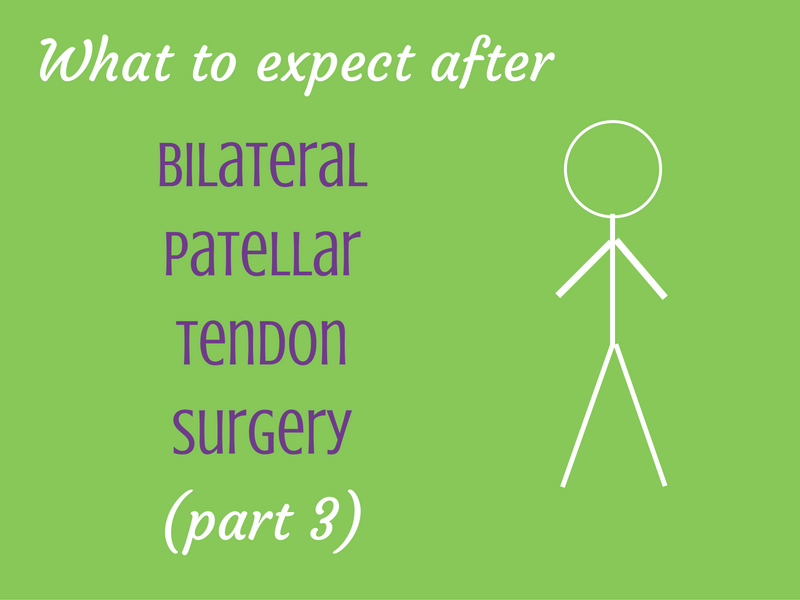
Welcome to part 3 of this series. You can read parts 1 and 2 to get you up to speed.
This is where things (meaning Mark) got going (finally). Things seemed to progress so quickly during this time period (from complete dependence for just about everything to almost complete independence) that it’s hard to remember what happened when but I’ll do my best.
Mark was scheduled to meet with the surgeon for the third time 4 weeks after his staples were removed. The transportation company cancelled at the last minute and we had to reschedule for the following week. Since his appointment was on a Thursday, it took almost another full week to schedule the initial consultation with a physical therapist who was highly recommended for this injury. My point is, your circumstances might put you a little ahead of Mark’s progress when you account for weekends and our delay.
We continued with the bending therapy in the meantime. The surgeon added heel slides. This engaged Mark’s quads. They sound easy but weren’t. Same set-up with locked leg resting on the ottoman. Mark sat on the edge of the chair with his other heel (unbraced leg) resting on a sliding board (sock or other cloth to reduce friction) and used his quad to pull the heel back, bending at the knee. This was another exercise that showed slow but definite progress. He got stronger and more steady by the day. This exercise also showed how much his quads had atrophied and couldn’t possibly support his body in a standing position. Crazy!
It’s important to note that we relied on a transportation company with a wheelchair van for all follow-up and therapy appointments until a couple of weeks into formal physical therapy. Luckily, worker’s comp covered this with no issue.
Weeks 6-12
Mark went to therapy at least 3 times before they had him stand (with crutches still locked in extension).
During these sessions, they moved his knee cap around, stretched him, measured his range of motion, loosened the quad muscles using a thing that resembled a butter knife and did e stim and ice.
Mark was also able to get into the pool with help of a lift. We chose this facility specifically for access to the pool. I have no doubt that this accellerated Mark’s progress. His ability to move freely in the water without braces improved his range of motion and leg strength without the risk of falling or unnecessary stress on his knees. It also helped with Mark’s stability. If you can rehab at a place with a pool, definitely choose that option.
On October 3, which was 2 months to the day after his surgery, Mark was on his feet for the first time. The blood rush to his feet was so uncomfortable and distracting that it was hard for him to focus on his balance.
Mark was so wobbly that first time that it was hard to imagine him walking again. But the therapists explained that his brain just had to remember what this standing was all about. They brought a full length mirror over to help the brain make the connection.
Fear is another factor here. He was on crutches with a therapist on either side but you have no confidence that your legs/knees won’t collapse.
Two days later, they got Mark on his feet for a few isometric and balance exercises. He was a lot more steady and a lot less fearful. He was confident enough to do a round at home. So, by his fourth day of therapy (weekend and days in-between) he was on his feet for exercises only. He was still locked in extension, so picture Frankenstein. Also, we still relied on the wheelchair to get anywhere in the house. It was another week before he was pivot transferring to and from the wheelchair instead of sliding or scooting into the chair.
By the end of the second week of therapy, he was allowed to take his braces off at night for sleeping and when he was just sitting around at home. His legs still didn’t bend easily on their own so he mostly still used the ottoman but would sit with his legs bent and resting on the floor for increasingly longer periods of time.
By his second full week of therapy, his sessions were 3-4 hours long. He worked in the gym standing, stretching, doing isometrics and other manipulations with a therapist nearly constantly at his side. They unlocked his braces to 30 degress and started letting him walk at therapy with crutches. If he buckled or tripped (which he didn’t), his legs wouldn’t bend more than 30 degrees. The crutches were more for stability than weight-bearing. He also did pool work (mini squats, walking, bicycles while floating in an inner tube, step-ups and downs, side steps) for 60-90 minutes then back to the gym for ice and estim for 30 minutes.
I accompanied him to therapy (driving him after he could sit in a car) because he needed help changing after his pool work. Remember, at this point, he wasn’t supposed to stand without the braces which makes it hard to undress and dress-especially when you’re wet.
Mark was able to manage by himself even after the pool sessions (freeing up my days and weeks considerably) at about the 12 week mark. HALLELUJA! It was just about at this time that Mark was cleared to do stairs and was finally able to sleep in our bed upstairs.
Some Final Random Notes:
This time period definitely saw the most notable progress. Mark got more independent by the day. We’re a few days from the 4 month anniversary. He still notices sustained but slow progress.
Mark’s knees are sore after therapy because they work him constantly. Ice and rest helps. He’s been walking without braces and crutches for about 3 weeks. He’s been showering (with a bench in our tub) since right around the 12 week mark. He still walks pretty stiff-legged, gets fatigued easily with too much walking or standing and has experienced swelling in the ankles for the same reason.
We took Luke to a tournament in New Jersey the weekend of November 12 (3 months and 1 week post-op). Mark had been cleared to drive but could only do so for about an hour before he got too stiff and sore. Also, his ankles were swollen when we got back. Probably 6 hours in a car and watching two long matches before that. Other than that, Mark can run errands on his own and drives himself to therapy.
Mark’s left knee is still behind the right in terms of range of motion and pain. Nobody seems to be concerned about it. As my friend (a PT) explained, you would never expect two injuries to respond exactly the same way, even in the same knee or joint. That makes sense but it’s frustrating and a little scary for him.
It’s too early to tell when Mark can return to work. If he had a desk job, it would be sooner. As a tennis pro, he’s typically on his feet 6-10 hours a day. That’s not possible at this point. Plus he needs the extensive therapy to continue to progress.
I don’t intend to write another whole post but will likely add a footnote to this one when he’s finally back to normal just to give you an idea of how long the process was for him beginning to end.
If you have any specific questions about this injury, caregiving, progress you can find my contact information by clicking the “contact” tab at the top of the page.

